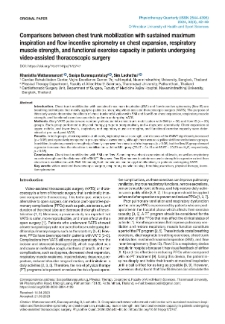Dolnośląska Biblioteka Cyfrowa udostępnia 101 825 obiektów cyfrowych
Obiekt
Tytuł: Comparisons between chest trunk mobilization with sustained maximum inspiration and flow incentive spirometry on chest expansion, respiratory muscle strength, and functional exercise capacity in patients undergoing video-assisted thoracoscopic surgery
Autor:
Wattanananont, Khanistha ; Buranapuntalug, Sasipa ; Laohathai, Sira
Abstrakt:
Wydawca:
Wydawnictwo Akademii Wychowania Fizycznego im. Polskich Olimpijczyków we Wrocławiu
Miejsce wydania:
Data wydania:
Typ zasobu:
Identyfikator zasobu:
Język:
Powiązania:
Physiotherapy Quarterly ; Physiotherapy Quarterly,2024,vol.32,nr4
Prawa:
Wszystkie prawa zastrzeżone (Copyright)
Prawa dostępu:
Dla wszystkich zgodnie z licencją
Licencja:
CC BY-NC-ND 4.0
Właściciel praw:
Wydawnictwo Akademii Wychowania Fizycznego im. Polskich Olimpijczyków we Wrocławiu
Kolekcje, do których przypisany jest obiekt:
- Dolnośląska Biblioteka Cyfrowa > Uczestnicy Konsorcjum
- Dolnośląska Biblioteka Cyfrowa > Uczestnicy Konsorcjum > 03. Akademia Wychowania Fizycznego we Wrocławiu
- Dolnośląska Biblioteka Cyfrowa > Uczestnicy Konsorcjum > 03. Akademia Wychowania Fizycznego we Wrocławiu > Czasopisma wydawane przez Akademię Wychowania Fizycznego we Wrocławiu
- Dolnośląska Biblioteka Cyfrowa > Zasoby
- Dolnośląska Biblioteka Cyfrowa > Uczestnicy Konsorcjum > 03. Akademia Wychowania Fizycznego we Wrocławiu > Czasopisma wydawane przez Akademię Wychowania Fizycznego we Wrocławiu > Physiotherapy Quarterly
Data ostatniej modyfikacji:
25 lut 2025
Data dodania obiektu:
25 lut 2025
Liczba wyświetleń treści obiektu:
1
Wszystkie dostępne wersje tego obiektu:
https://dbc.wroc.pl./publication/170666
Wyświetl opis w formacie RDF:
Wyświetl opis w formacie OAI-PMH:
Podobne
Botla, Afaf M. Ebrahim, Reham S. Elkosery, Soheir M. Darwesh, Ahmed M. Mohamed, Dina M.A.
Ahmed, Faruq Islam, Shofiqul Hassan, Nazmul Ahmed, Shahoriar Sultan Nahid, Zahid Bin Hoque Rase, Aminul
Jung, Michael Wilhelm Schubert, Patric Stephenson, Antonia Bader, Peter
























